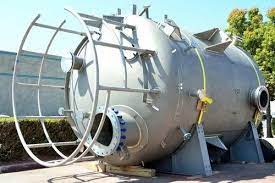|

Reactors are crucial for chemical processes. They must be well-designed to ensure safe operation and optimum performance. The design process is based on reaction kinetics and engineering analysis.
Reactions can be performed continuously or in batches. In continuous operations, the residence time is controlled by the feed rate to the reactor volume.
Batch
Batch reactors are non-continuous chemical processing equipment that produce a product in a single pass. They contain a vessel wherein the reactants are fed and they react with each other. The product is then removed from the vessel. They are used in industrial processes like manufacturing colorants and margarine. These reactors come in different sizes but they have the same basic design. They have a cylindrical shape with an agitator in the center. The agitator helps to mix the reactants thoroughly so that they can react effectively. It also helps to remove the byproducts.
They are mostly operated with gas, steam or hot water, although some can be run on electricity as well. They are usually made from glass-lined steel, stainless steel or some other material and have ports for adding liquids or solids. The vessels are usually large and can be over fifteen thousand gallons in capacity. They are used in a number of different industries, such as the pharmaceutical and oil and gas sectors.
The advantage of using a batch reactor is that it is much easier to control than continuous processing. It is also more economical. However, the production time is longer and the yield of the product is lower than that of a continuous system. The main disadvantage of a batch plant is that energy consumption is high. Energy consumption contributes a lot to production costs and is a source of environmental hazard. It is therefore essential to find ways of reducing the energy consumption of batch plants.
One of the most important factors in a batch reactor is its ability to change over between different reactions. This is especially important in multiproduct factories where the same equipment is used for different products. A quick changeover enables manufacturers to minimise downtime for cleaning and maintenance, reduce the inventory costs of finished goods, and improve quality and environmental sustainability.
Another factor that affects the energy use of batch reactors is the rate at which heat is added or absorbed. The action of stirring stored liquids generates a lot of heat. This needs to be balanced with the temperature of the reactor contents. This is done by either heating or cooling the batch reactor with coils or jackets. Heat transfer fluid circulates through the coils or jacket to add or remove heat. buy reactors from best affordable seller surplusrecord.
Batch reactors are often equipped with heat integration systems to help in saving energy. These are usually designed to maximise the energy efficiency of the reaction. It is also possible to optimise energy usage through model predictive control. This technique combines a mathematical model of the process with the outputs from sensors and actuators.
Continuous
A chemical reactor is an enclosed volume where a chemical reaction takes place. The reaction takes place under the control of a chemical engineer who makes sure that the reactions are carried out with the highest efficiency to produce a product. It is a key part of chemical engineering and has several applications including petrochemicals, pharmaceuticals, polymers and dyes. Chemical reactors are a vital tool in industrial processes because they reduce the amount of energy and raw materials needed to produce the final product. They also enhance safety in industrial processes by minimizing the risk of accidents and reducing the exposure of workers to hazardous chemicals.
There are two basic types of chemical reactors: batch and continuous. Continuous used reactors are usually used for larger productions while batch reactors are generally used for smaller quantities of products. Both can be made up of steel, stainless steel or glass. The major difference between the two is that batch reactors require the reactants to be added one at a time, while continuous reactors allow the reactants to flow in continuously.
Batch reactors are often more cost-effective for small-scale production, particularly when the product specifications require a high level of purity or consistency. Moreover, these reactors are usually simpler and less complex than continuous reactors. In addition, they can be easily cleaned and are therefore suited for applications in which only limited amounts of a specific product are required at any given time.
Continuous reactors are usually more expensive than batch reactors, but they offer many benefits. They are typically more efficient and produce a higher-quality product than batch reactors. Additionally, they can be easily scaled up to meet production requirements, which reduces operating expenses. They also require less space for storage of both raw materials and the finished product.
There are various different types of continuous chemical reactors, but the most common type is the PFR (Plug Flow Reactor). This type of reactor has a tubular design and has an agitator at the bottom. The agitator is used to keep the reactants in constant contact with each other so that they can react efficiently. During the reaction, the concentration of the reagents decreases while the concentration of the products increases. This causes the rate of the reaction to slow down as it progresses. The PFR is controlled by the use of control rods that can be inserted or withdrawn to alter the reaction rate. The resulting mixture is then pumped through a filter where any remaining solids are removed. The regenerated catalyst can then be returned to the reactor for further reaction. This process is known as catalytic cracking.
|